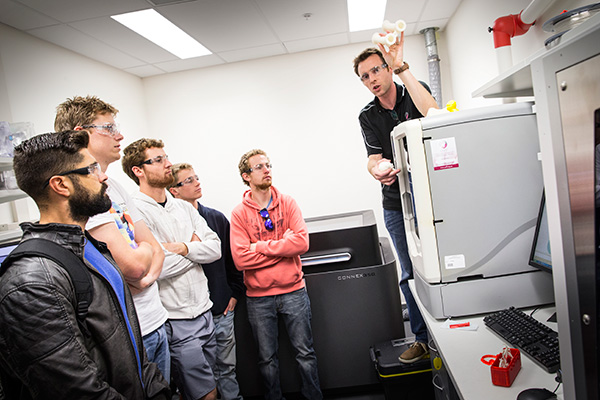September 16, 2014
Engineering students build knowledge and careers layer-by-layer
A new subject introducing engineering students to 3D printing promises to be a catalyst for a booming field of study over the coming years.

ACES Research Fellow Dr Stephen Beirne shows undergraduate engineering students the capabilities of 3D printing equipment at the UOW-based Australian National Fabrication Facility (ANFF).
From printed human organs to complex mechanical components with moving parts – 3D printing has shaken up the rules for design and manufacturing.
The (MMM) in the Faculty of Engineering and Information Sciences (EIS) is now offering engineering students the opportunity to get ahead of the innovation curve through a new subject that will have students designing and building their own 3D-printed objects.
Head of the School, Professor Gursel Alici, who is also the leader of the Soft Robotics for Prosthetic Devices research theme at the UOW-headquartered , said the school has been striving to equip its students with cutting-edge knowledge and skills in order to give them an edge in taking the full advantage of this new technology in their professional life.
"The school’s next plan is to link 3D printing with biomedical engineering through offering new specialised subjects that will have a real impact on novel medical technologies" he said.
"This will help consolidate UOW's national and international competitiveness in research and teaching."
The subject will take students through a complete design and build cycle where they will be asked to identify a product that is suitable for manufacture by 3D printing, either an existing device that requires redesign, or a new creation altogether.
The design process includes generating design concepts and eventually a 3D computer model that is converted to a format suitable for 3D printing. After the design is printed it will be tested to assess its technical performance.
Students will also study fundamental knowledge of the history, principles and processes of 3D printing.
Subject coordinator Dr Steven Harvey said 3D printing represented a major shift in approaches to manufacturing. He said while traditional manufacturing involves processes such as machining, casting and forging where material is removed to reveal the final design, 3D printing builds a computer-generated design layer-by-layer.
“This revolution has opened up a wealth of opportunities in the production of fully customisable, non-uniform objects that were previously impossible to manufacture conventionally,” Dr Harvey said. “We are no longer restricted by the traditional constraints imposed by conventional engineering tools. We are teaching ‘What You See Is What You Build’. If you can visualise it on screen in 3D then you can most likely build it.”
The subject will provide students with the skills to become proficient with 3D printing, a field that is itself developing at a rapid rate. This has taken engineering education full-circle to again become a hands-on activity.
What is slowly emerging from industry feedback is that a different type of engineering graduate, one well-versed in the creative as well as the technical areas of design is what is now required,” Dr Harvey said.
Students will see 3D printing applied to a range of settings, including at ACES, where the technology is used in building and implants. Technicians are even combining science and art to help produce in collaboration with Illawarra-based metalsmith Cinnamon Lee.
Yet those well versed in 3D printing maintain that the technology is another tool at their disposal and will not replace traditional manufacturing techniques.
“We are now in the era of ‘mass customisation’, and this has particular application in the medical device and aerospace fields,” Dr Harvey said. “But this property is also one of its weaknesses. Three-dimensional printing cannot, at the moment anyway, hope to compete with the traditional mass production manufacturing techniques such as injection moulding or investment casting.
“It is simply too slow and still requires a high degree of human intervention to remove support structures in post-processing. Engineering graduates will still need, for the foreseeable future, a very strong grounding in traditional manufacturing fundamentals.”
Three-dimensional printing continues to push boundaries in previously unheard of materials combinations and complex shapes. New disciplines are emerging, such as biofabrication, where 3D printing processes are being adapted to enable construction of body parts and implants using hydrogels and other materials compatible with the human body.
“Even industry is struggling to keep up with the high rate of development in 3D printing,” Dr Harvey said. “The jobs of the future do not even exist at the moment. We are seeing only the tip of the iceberg. And the best part for students is that they can join the bandwagon at any time and immediately get ahead of the rest of the pack.”